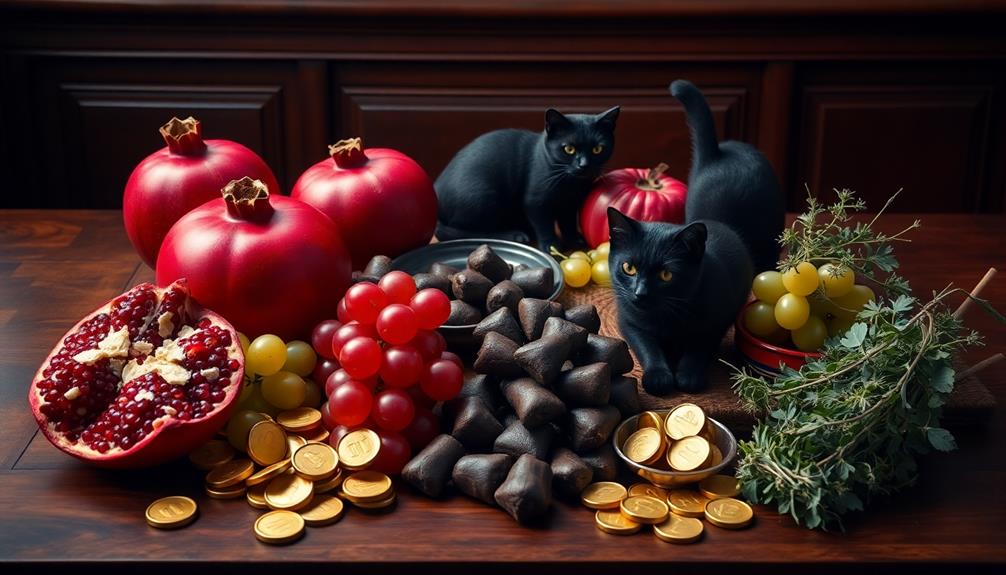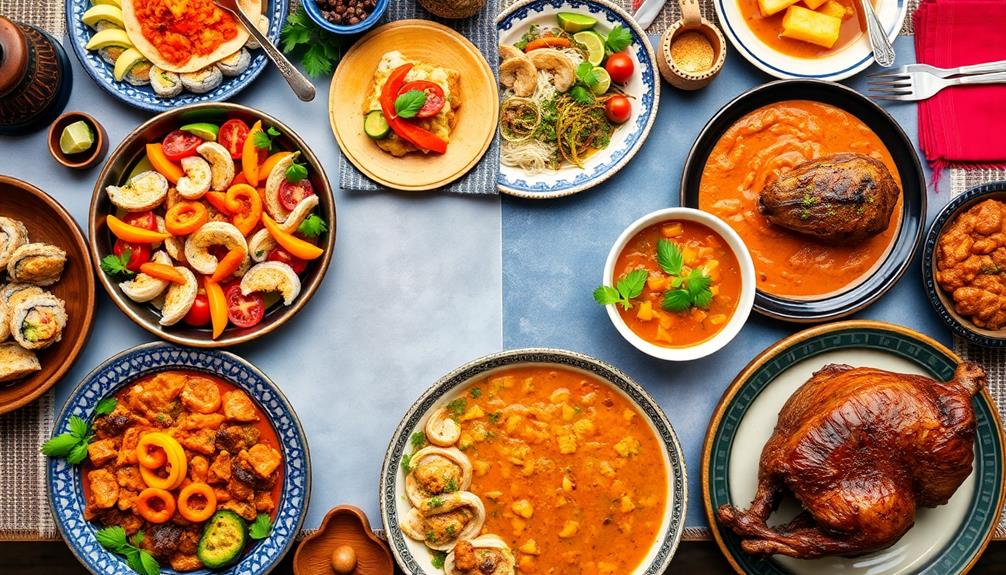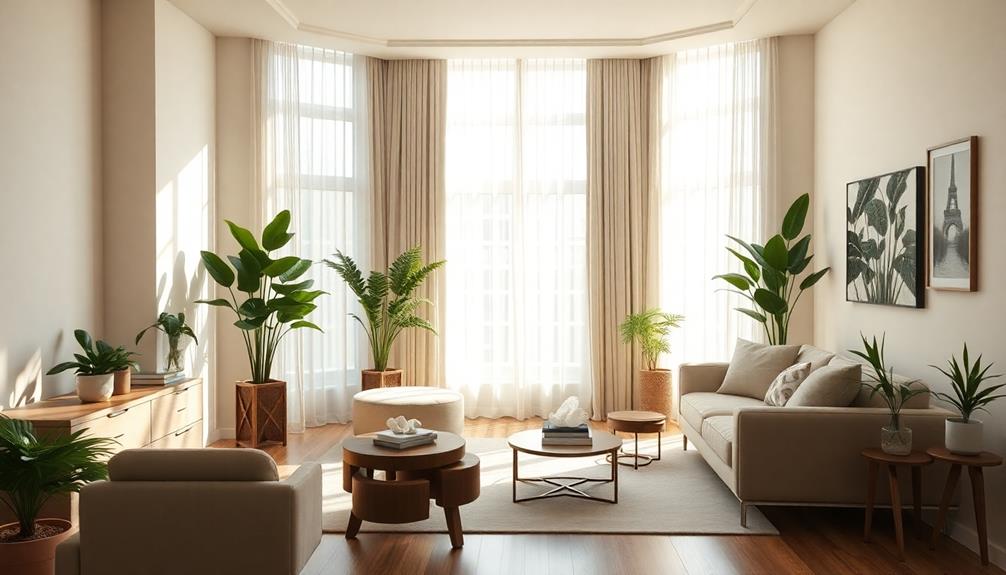Batik's intricate patterns and rich symbolism can transform your modern interiors into vibrant narratives of culture and meaning. Originating from Indonesia, batik represents unity, love, and protection through its unique designs. You can use striking pieces like wall-mounted batik panels or colorful cushions to infuse your space with character and depth. Combining these textiles with solid colors enhances visual interest without overwhelming your decor. By embracing batik, you not only honor its heritage but also add a unique touch to your home. Keep exploring, and you'll uncover even more ways to integrate this beautiful art form into your space.
Key Takeaways
- Batik patterns like Kawung and Parang symbolize unity and protection, enhancing the cultural narrative of modern interior designs.
- Incorporating batik textiles as accent pieces introduces vibrant colors and textures, enriching the aesthetic appeal of contemporary spaces.
- The deeper meanings behind batik motifs, such as love and social status, create layers of storytelling in interior decor.
- Using batik in large focal points or as subtle accents maintains aesthetic coherence while celebrating Indonesian heritage.
- Blending batik with modern materials and designs aligns traditional craftsmanship with contemporary aesthetics, appealing to diverse audiences in interior design.
The Origins of Batik
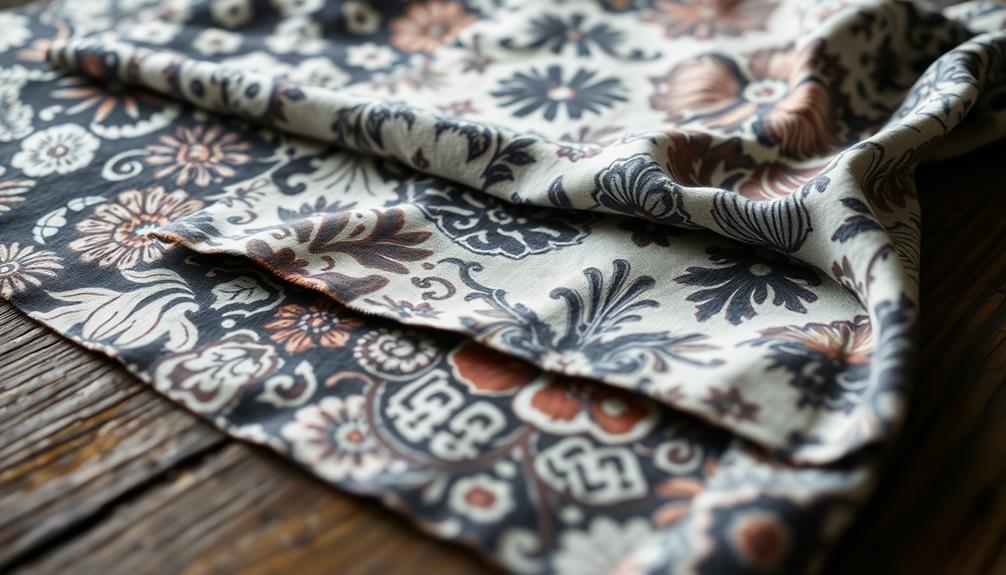
Batik weaves a rich tapestry of history that dates back over 2,000 years to the island of Java in Indonesia. Its origins lie in the intricate textile traditions of the region, where artisans developed the unique wax resist technique that defines batik today.
The term "batik" comes from the Javanese word "ambatik," meaning cloth with little dots, which perfectly captures the detailed patterns that characterize this art form. These vibrant designs often reflect local traditions and cultural narratives, similar to how traditional artistry is expressed in Indonesian decor masks.
Initially, batik was reserved for royalty, serving as a means of spiritual expression and social status. Each design held symbolic meanings, often connected to nature and virtues, reflecting the deep cultural heritage of the Indonesian people.
As trade routes expanded, batik evolved, integrating techniques from various cultures across Asia, Africa, and Europe, enriching its already diverse history.
In 2009, UNESCO recognized batik as a Masterpiece of Oral and Intangible Heritage, highlighting its significance in maintaining cultural identity and artistic expression.
Today, batik continues to inspire, showcasing a fusion of tradition and modernity in both fashion and interior design, allowing you to connect with its rich history in your own space.
Symbolism in Batik Patterns
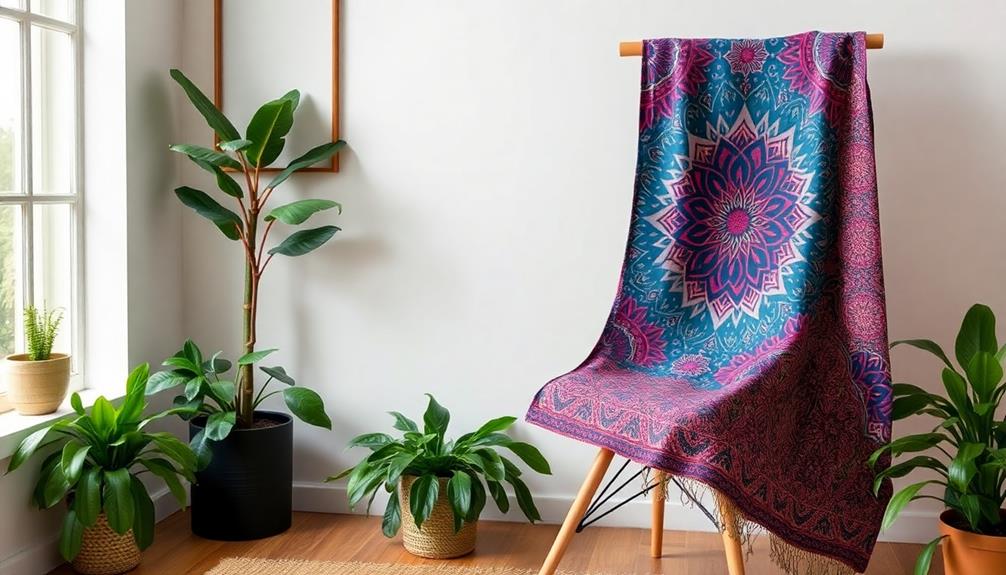
In the world of batik, patterns are more than just decorative elements; they embody deep cultural significance and tell stories of heritage and identity. Batik patterns, like Kawung and Parang, carry rich symbolism that influences your interior design choices.
For instance, Kawung represents unity and balance, while Parang symbolizes power and protection, making them meaningful additions to your space. The vibrant colors and intricate designs of batik serve as powerful storytelling tools, reflecting cultural meanings that resonate with you and those who enter your home.
Indonesian decorative pillows can beautifully complement these patterns, enhancing the overall aesthetic of your interiors. Colors play a crucial role, too; red signifies courage and passion, while blue represents calmness and wisdom, altering the emotional tone of your interior spaces.
Patterns such as Sido Asih, associated with love, are perfect for gathering areas, enhancing connections among family and friends. By incorporating these traditional motifs into your decor, you merge timeless heritage with modern aesthetics.
Contemporary interpretations of batik allow you to celebrate its rich history while creating a vibrant, personalized living environment that speaks to your unique story. Embrace the symbolism in batik patterns and transform your interiors into a canvas of cultural narrative.
The Batik Dyeing Process
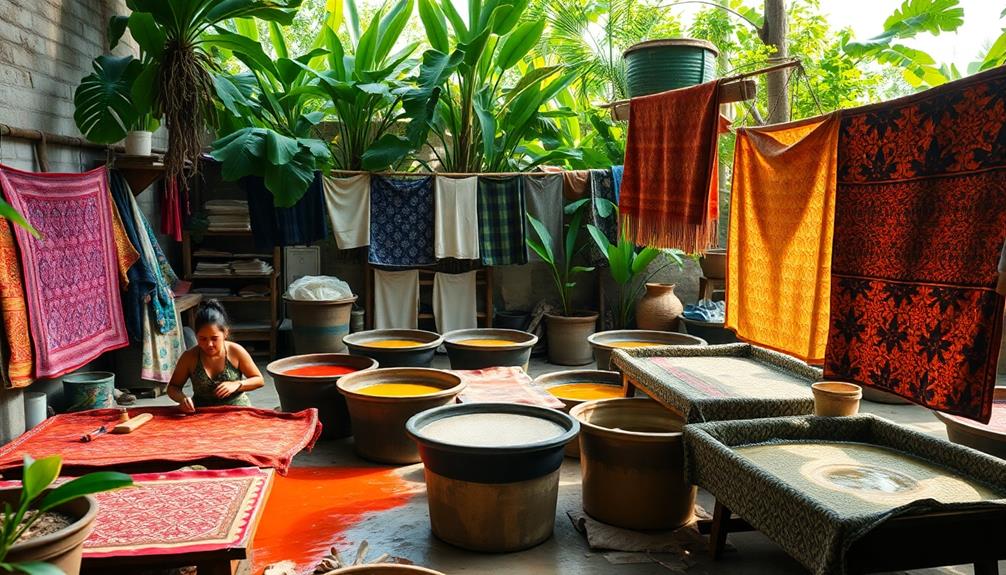
Understanding the intricate symbolism of batik patterns enriches your appreciation for the craft, but it's equally fascinating to explore how these stunning designs come to life. The batik dyeing process begins with natural fabrics like cotton and silk, stretched on a frame for design application. Artisans use hot wax applied with a canting tool to create intricate patterns.
After applying the wax, the fabric is immersed in a dye bath, allowing the dye to penetrate areas not covered by wax. Once the dyeing is complete, the wax is removed by heating the fabric, typically with an iron, revealing the beautiful contrasting colors and designs.
Two primary techniques are used in batik:
| Technique | Description |
|---|---|
| Batik Tulis | Hand-drawn, labor-intensive process |
| Batik Cap | Utilizes copper stamps for quicker production |
The dyeing technique can involve multiple rounds of waxing and dyeing to achieve layered colors and depth in the final design. This showcases the artisan's skill and creativity, making each piece a unique work of art.
Batik's Cultural Significance

Rich in cultural significance, batik motifs tell stories that resonate deeply within Indonesian society. Each intricate design carries layers of symbolism, reflecting the nation's rich cultural heritage. Batik isn't just fabric; it's a canvas for artistic expression that connects generations through family heirlooms.
Additionally, many batik patterns are similar to the intricate designs found in traditional Indonesian decor masks, highlighting the shared artistic heritage. Here are some key aspects of batik's cultural significance:
- Social Status: Certain motifs, like the Parang pattern, represent power and protection, indicating the wearer's social standing.
- Ceremonial Use: Specific designs are worn during important life events, conveying blessings and honoring ancestral spirits in celebrations and funerals.
- Recognition: Batik is recognized by UNESCO as a Masterpiece of Oral and Intangible Heritage, underscoring its crucial role in shaping Indonesian identity.
- Modern Influence: While rooted in tradition, batik influences contemporary fashion and interior design, showcasing its versatility and relevance today.
Celebrated annually on National Batik Day, this art form promotes awareness and appreciation for its rich history and symbolism.
Integrating Batik in Interiors

Batik's intricate patterns and vibrant colors offer a unique way to enhance your interior spaces, blending tradition with modern aesthetics. You can easily integrate batik textiles into your decor by using them as vibrant accent pieces, like throws, cushions, or curtains. Their intricate designs and traditional patterns can elevate your interior design while adding a touch of cultural richness.
Additionally, incorporating elements like Indonesian decor masks can further improve the aesthetic appeal and cultural storytelling within your space, making it a true reflection of your personal style and appreciation for Indonesian artistry and craftsmanship.
In modern bohemian interiors, consider wall-mounted batik panels. They create a striking focal point, enriching the space and drawing attention. To maintain a harmonious blend of styles, choose batik patterns that complement your existing decor schemes; this guarantees your space remains cohesive without feeling overwhelmed.
Antique-inspired batik textiles are particularly effective for infusing unique character into contemporary spaces. They bridge the gap between traditional craftsmanship and modern design sensibilities, enhancing your interior spaces with depth and personality.
The versatility of batik allows it to fit seamlessly into various design styles, from traditional to minimalist. By thoughtfully incorporating these beautiful textiles, you can transform your home, showcasing the vibrant heritage of batik while enjoying a stylish, modern environment.
Contemporary Batik Trends
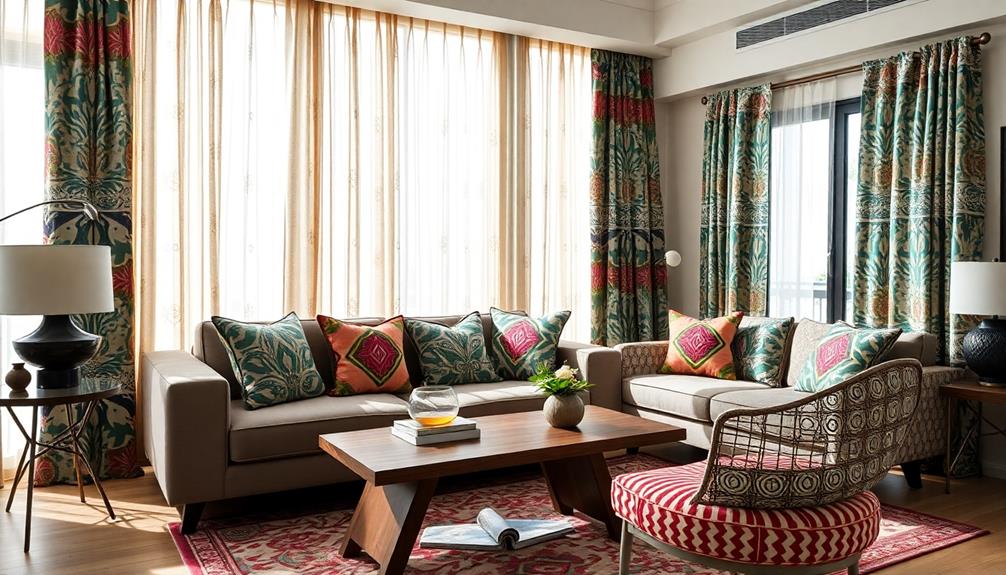
Contemporary batik trends seamlessly blend traditional motifs with modern designs, making them a favorite for both young audiences and interior designers.
You'll notice vibrant colors and intricate patterns popping up in everything from cushions to wall art, enhancing your home's aesthetic with a touch of cultural flair.
This revival of batik also resonates with the luxury and tropical design aesthetics promoted by firms like Mahallati Interiors, which emphasize high-quality materials and local craftsmanship.
Plus, the focus on sustainable practices and collaborations with designers keeps batik relevant in today's fashion and interior spaces.
Modern Interpretations of Batik
Often, you'll find that modern interpretations of batik have breathed new life into this cherished art form, making it accessible and appealing to a younger audience.
By blending traditional batik techniques with contemporary aesthetics, designers have created innovative designs that celebrate cultural heritage while fitting seamlessly into today's home decor. This evolution mirrors the principles of Balinese Interior Design, which emphasizes natural materials and open spaces.
Here are some exciting trends to reflect upon:
- Vibrant Patterns: Modern batik features bold, colorful prints that serve as striking focal points in any space.
- Synthetic Dyes: The use of synthetic dyes allows for a wider palette and easier maintenance, making batik textiles practical for everyday use.
- Unique Applications: Batik-inspired textiles are now found in throw pillows, curtains, and wall art, enhancing various interior design styles.
- Collaborative Creations: Partnerships between traditional batik artisans and contemporary designers result in pieces that bridge heritage with modernity.
These elements make batik not just a decor choice, but a statement of style and cultural appreciation, proving that this timeless technique can thrive in our modern interiors.
Batik in Fashion Design
In recent years, the fashion industry has embraced batik like never before, blending traditional patterns with modern silhouettes to create enchanting styles. Designers are increasingly using batik fabric in high-fashion collections, showcasing batik-inspired pieces on international runways.
This trend not only appeals to a younger audience but also honors cultural heritage, reflecting a deep appreciation for intricate designs and vibrant colors, much like the traditional Indonesian style home decor that emphasizes harmony with nature.
The fusion of batik with Western fashion elements has sparked innovative styles. You'll find unique garments that combine batik prints with contemporary cuts and materials, embodying both tradition and modernity.
Accessories like scarves and bags made from batik fabric allow you to incorporate this cultural textile into your everyday wardrobe, adding a touch of artistry to your outfits.
Moreover, eco-friendly practices are influencing batik production, with many designers opting for sustainable fabrics and natural dyes. This shift promotes environmental consciousness while celebrating the rich history of batik.
As you explore contemporary batik trends in fashion design, you'll discover how these elements come together to create pieces that aren't only stylish but also meaningful, bridging the gap between the past and the present.
Practical Tips for Using Batik
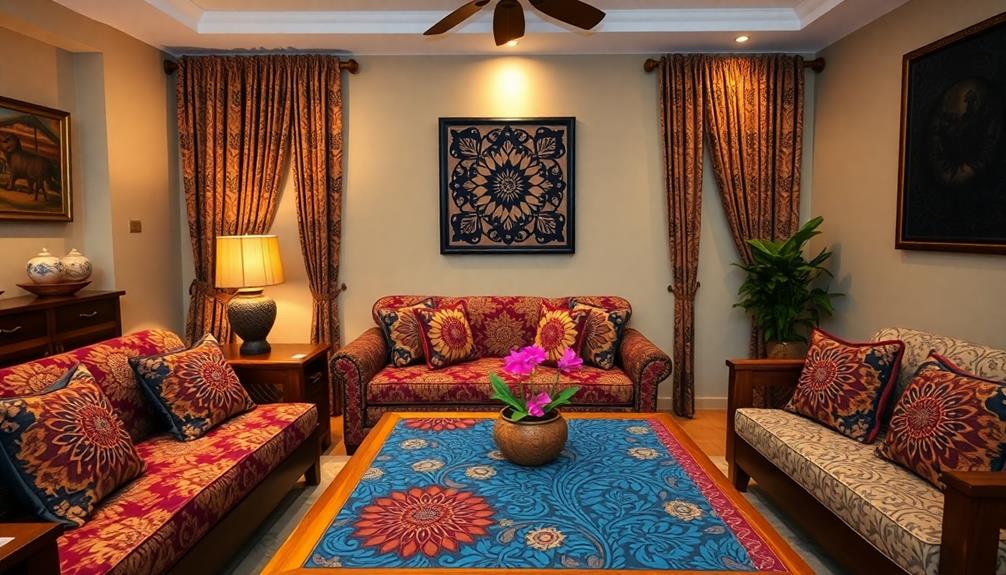
When you're incorporating batik into your space, choosing patterns that complement your existing decor is key.
Balancing vibrant batik designs with solid colors can create a harmonious look that enhances your interior.
Choosing Complementary Patterns
Incorporating batik into your interior design can be a rewarding experience, especially when you choose patterns that complement your existing decor. To create a cohesive look, consider these practical tips:
- Mix with Solid Colors: Pair vibrant batik motifs with solid-colored furniture or accents to highlight the rich designs of the batik without overwhelming the space. This technique is similar to using Indonesian Wedding Decor Ideas that balance intricate patterns with simpler elements.
- Consider Scale: Use larger batik patterns as focal points in spacious areas, while smaller patterns fit better in intimate settings, ensuring they don't dominate the room.
- Blend Textile Styles: Combine batik with natural fabrics like linen or cotton. This mix enhances visual interest, creating a balanced and inviting atmosphere.
- Utilize Accent Pieces: Introduce batik through cushions or throws. These accent pieces add color and texture to your space, allowing for easy updates with seasonal trends.
As you select batik items, be mindful of color palettes. Choose shades that either complement or effectively contrast with your wall colors and furnishings to elevate your room's overall aesthetic.
With these tips, you can seamlessly integrate batik into your interior design.
Balancing With Solid Colors
Balancing vibrant batik patterns with solid colors can elevate your interior design and create a harmonious space. To start, use batik designs as accent pieces—think cushions or throws—against solid-colored furniture. This approach enhances visual interest while allowing the intricate patterns and vibrant colors of batik to shine without overwhelming the room.
Incorporating elements like modern tropical aesthetics in Bali can further improve the connection between batik and your overall design, creating a seamless blend of cultures.
Consider the unique motifs within your batik, like the Kawung or Parang, which carry traditional uses and symbolic meanings. Mixing these intricate patterns with solid colors highlights their craftsmanship and depth. To avoid visual clutter, limit your batik use to small doses. This guarantees the designs complement rather than compete with other decor elements.
Selecting a cohesive color palette is also key. Choose shades found within the batik to unify your decor, seamlessly integrating this traditional textile art into modern interiors.
Frequently Asked Questions
What Does Batik Symbolize?
Batik symbolizes cultural identity and heritage, reflecting values like power, unity, and protection. Each pattern you choose can convey deeper meanings, connecting you to traditions and enhancing your understanding of its historical significance.
Why Is Batik so Special?
When you get down to brass tacks, batik's special because it combines rich history, vibrant colors, and intricate designs. It's not just fabric; it's a cultural story that enhances any space you create.
What Is the Meaning of Batik in Art?
Batik in art represents deep cultural meanings, with each motif and color conveying specific values. You'll find it reflects heritage, infuses spirituality, and tells stories, making it a unique expression of identity and tradition.
How Is Batik Used in Everyday Life?
Batik's vibrant patterns symbolize cultural heritage, enriching your everyday life. You wear it as clothing, decorate your home with it, and carry it as accessories, seamlessly blending tradition with modern style in your daily routine.
Conclusion
As you weave batik's vibrant patterns into your space, you're not just decorating; you're telling a story rich with culture and meaning. Each design whispers tales of heritage and artistry, transforming your home into a sanctuary of history and emotion. Embrace the beauty of batik, and let it breathe life into your interiors, creating a tapestry of warmth and connection that echoes through time. Remember, every piece holds a heartbeat of tradition waiting to resonate in your life.


